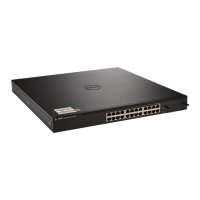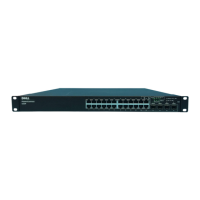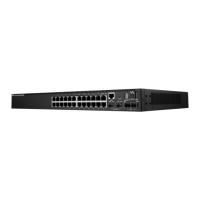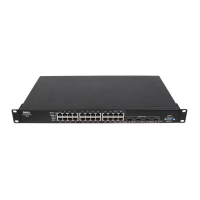148 Managing a Switch Stack
Adding a Switch to the Stack
When adding a new member to a stack, make sure that only the stack cables,
and no network cables, are connected before powering up the new unit. Stack
port configuration is stored on the member units. If stacking over Ethernet
ports, configure the ports on the unit to be added to the stack as stacking
ports and power the unit off prior to connecting the stacking cables. Make
sure the links are not already connected to any ports of that unit. This is
important because if STP is enabled and any links are UP, the STP re-
convergence will take place as soon as the link is detected.
After the stack cables on the new member are connected to the stack, you can
power up the new units, beginning with the unit directly attached to the
currently powered-up unit. Always power up new stack units closest to an
existing powered unit first. Do not connect a new member to the stack after it
is powered up. Also, do not connect two functional, powered-up stacks
together. Hot insertion of units into a stack is not supported.
If a new switch is added to a stack of switches that are powered and running
and already have an elected stack master, the newly added switch becomes a
stack member rather than the stack master. In this situation, the firmware of
the new unit may be overwritten based on the configuration of the stack
master. The running configuration of the newly added unit is overwritten
with the stack master configuration. Stack port configuration is always stored
on the local unit and may be updated with preconfiguration information from
the stack master when the unit joins the stack.
You can preconfigure information about a stack member and its ports before
you add it to the stack. The preconfiguration takes place on the stack master.
If there is saved configuration information on the stack master for the newly
added unit, the stack master applies the configuration to the new unit;
otherwise, the stack master applies the default configuration to the new unit.
Removing a Switch from the Stack
Prior to removing a member from a stack, check that other members of the
stack will not become isolated from the stack due to the removal. Check the
stack-port error counters to ensure that a stack configured in a ring topology
can establish a communication path around the member to be removed.
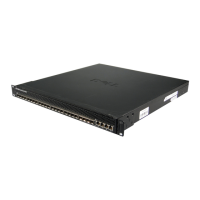
